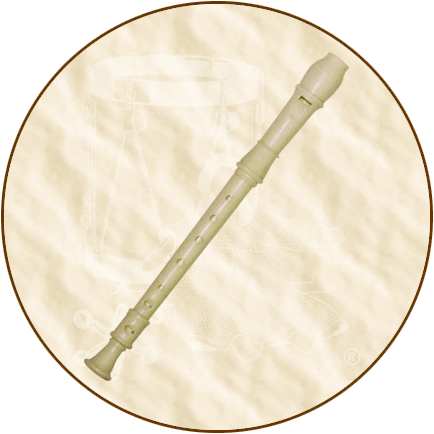.
Continued from product description on
Folk Instruments' Page Two...
Historical
Background: The recorder is a member of the whistle (or
fipple) family of flutes. This wind instrument is also the most
highly developed member of the internal duct flute family. Its
seven finger holes and one thumb hole (an octaving vent) distinguish
it from other internal duct flutes. The fipple (or block) at
the blowing end creates a narrow air stream before it passes
through the bore in the body. The fipple and the recorder's wide,
tapering conical bore create a tonal quality that is highly individual,
soft, and slightly reedy. The fipple family of flutes also includes
the flageolet, the three-hole tabor pipe, and, of course, the
whistle.
Wind instruments (and especially whistle-type instruments)
have been made for thousands of years. For example, a sheep-bone
whistle from the Iron Age has been uncovered in England. However,
the development of the recorder is more recent and possibly could
have occurred as early as six or seven centuries ago during the
Mediaeval Period. It is uncertain as to exactly when since none
have (so far) been discovered from this time period. A mid-13th-century
recorder was discovered in a moat near Dordrecht, Holland, in
1940, but there is no way to know how typical it was since none
of its contemporaries has been located (yet). After the Dordrecht
Recorder, the next surviving Medieval recorder is the Göttingen
Recorder dating from the 14th century.
Recorders are typically made using a variety of hardwoods,
such as ebony, maple, rosewood, and other fruit woods. In earlier
times, recorders were likely made of boxwood. On occasion, they
were even decorated with ivory or made entirely from ivory! Today,
there are many types and sizes of recorders being used (and pitched
in different keys). The smallest is the sopranino recorder and
the largest is the contra bass recorder. Other recorders are
(from larger to smaller): the great bass, bass, tenor, alto (or
treble), and soprano (or descant).
In addition to the traditional recorder, there are also two-piece
pentatonic recorders. These have four finger holes and are played
with two fingers from each hand. They play two octaves of a plagal
scale and can play a fourth lower than the pitched key. Pentatonic
recorders are available as: sopranino in C, sopranino in B flat,
soprano in G, soprano in F, alto in D, and alto in C.
At present, there is no conclusive evidence that the recorder
existed before the 16th century's Late Renaissance Period (circa
1550-1600 A.D.). Renaissance recorders had a large bore and were
so slightly tapered they were often referred to as cylindrical.
Several recorders from this period have survived and give us
an understanding of what these instruments sounded like. Unlike
the softer, more refined sound of Baroque instruments, Renaissance
recorders have a more robust and much louder sound -- particularly
in the lower register. Their design was plain with little or
no decorative features. One unique characteristic of a Renaissance
recorder was two bottom holes. This was done so that both right-handed
and left-handed players could use the instrument. Depending on
the player's preference, one of these holes was plugged with
wax.
The recorder we know today comes from the Baroque Period (1600-1750).
During the 17th century, the recorder's bore began to sharply
taper out. This came about because instrument makers at that
time wanted to achieve a larger range of notes and create a more
refined, flexible sound for soloists. The result was a much softer-sounding
instrument. To some, this was a disadvantage when it came to
using it in Orchestral music. Nevertheless, composers such as
J.S. Bach and his contemporaries occasionally wrote "flauto"
parts for the recorder or "cross flute" (or "German
flute"). Later, Bach, Georg Friedrich Handel, Henry Purcell,
and G.P. Telemann would make use of a "flauto piccolo"
(or "flautino"), a small recorder usually an octave
higher in pitch than a flauto.
Beginning in the early 1700s, the recorder started gaining
popularity as a transverse flute (or "traverso"). Transverse
flutes were louder and had a wider range of notes. These two
characteristics made them more suitable for Orchestral music
which, by this time, was starting to come into vogue. Meanwhile,
the soft-spoken recorder remained an important part of Chamber
music.
Also at this time, the recorder started becoming less popular
with the masses, and this trend continued until it disappeared
almost entirely from the music scene. By the beginning of the
1800s, the recorder was only played as a historical curiosity.
And because of its lack of demand, the art of making recorders
almost disappeared as well. This was nearly a disastrous event
considering just how sophisticated an instrument the recorder
is to make!
It would not be until the music revival of the late 1800s
and early 1900s that recorders would make a comeback, thanks
mostly to an English music antiquarian and scholar named Arnold
Dolmetsch. Dolmetsch's book, "The Interpretation of the
Music of the XVIIth and XVIIIth Centuries" (London, 1915),
is a landmark revival of the performance practices of ancient
music.
By the end of the 20th century, the recorder had become more
popular than at any other time in its musical history. Throughout
this century, the vast majority of American public schools used
recorders to teach music principles to generations of elementary
school students. Today, recorders are manufactured by the millions
annually. The recorder's repertoire is also increasing, thanks
to a large group of imaginative players. And while most recorders
are made after historical models, radical advancements by instrument
makers are extending players' possibilities with this instrument.
Fun
Fact: The German name for fipple flute is "block
flute."
Fun
Fact: Paintings show the use of the recorder during the
Middle Ages and Crusades!
Fun
Fact: King Henry VIII of England had a collection of 76
recorders at the time of his death in 1547 and even composed
music for these instruments!
Fun
Fact: The earliest unambiguous illustration of a recorder
is a fresco entitled "The Mocking of Jesus" (circa
1315 A.D.) in the Church of St. George at Staro Nagoricvino,
Macedonia (now Yugoslavia).













